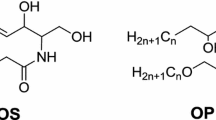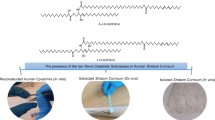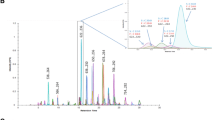Abstract
Stratum corneum lipids are responsible for the skin’s barrier function. They are the final product of epidermis lipid biosynthesis. During this process, lipids evolve from simple to complex structures in three main levels respectively (stratum basal level, stratum granulosum level, and stratum corneum level). Our aim was to simultaneously analyze and characterize the structure of total epidermis lipids. A powerful analytical method (normal-phase liquid chromatography coupled with high-resolution mass spectrometry (NPLC/HR-MSn)) was developed in order to separate, in a single run, lipid classes with a wide polarity range. Chromatographic conditions were particularly designed to analyze lipids of intermediate polarity such as ceramides. Rich information was obtained about the molecular structure of keratinocyte differentiation biomarkers such as ceramides, glucosylceramides, and sphingomyelins and the microstructures of reconstructed human epidermis lipids using HR-MSn. A new subclass of ceramides, 1-O-Acyl Omega-linoleoyloxy ceramides [1-O-E (EO) Cer] has been highlighted. This class is double esterified on the 1-O-position of sphingoid base with long to very long chain acyl residues (1-O-E) and on the position of ω-hydroxyl group of fatty acid with the linolenic acid (EO). Considering its chemical structure and hydrophobicity, this subclass can contribute to the skin barrier. In addition, we detected a new epidermis sphingomyelins. Our lipidomic approach offers a direct access to epidermis biomarkers.




Similar content being viewed by others

Abbreviations
- APCI:
-
Atmospheric pressure chemical ionization
- APPI:
-
Atmospheric pressure photoionization
- CER:
-
Ceramide
- ESI:
-
Electrospray ionization
- FFA:
-
Free fatty acid
- GlcCER:
-
Glucosylceramide
- HPLC:
-
High-performance liquid chromatography
- HR-MS:
-
High-resolution mass spectrometry
- LA:
-
Linoleic acid
- NPLC:
-
Normal-phase liquid chromatography
- RHE:
-
Reconstructed human epidermis
- RP-LC:
-
Reversed-phase liquid chromatography
- SC:
-
Stratum corneum
- SM:
-
Sphingomyelin
- Sph:
-
Sphingoid base moiety
- ULC:
-
Ultra-long chain
References
Breiden B, Gallala H, Doering T, Sandhoff K. Optimization of submerged keratinocyte cultures for the synthesis of barrier ceramides. Eur J Cell Biol. 2007;86(11–12):657–73.
Franzke CW, Cobzaru C, Triantafyllopoulou A, Loffek S, Horiuchi K, Threadgill DW, et al. Epidermal ADAM17 maintains the skin barrier by regulating EGFR ligand-dependent terminal keratinocyte differentiation. J Exp Med. 2012;209(6):1105–19.
van Drongelen V, Alloul-Ramdhani M, Danso MO, Mieremet A, Mulder A, van Smeden J, et al. Knock-down of filaggrin does not affect lipid organization and composition in stratum corneum of reconstructed human skin equivalents. Exp Dermatol. 2013;22(12):807–12.
Vyumvuhore R, Tfayli A, Duplan H, Delalleau A, Manfait M, Baillet-Guffroy A. Effects of atmospheric relative humidity on stratum corneum structure at the molecular level: ex vivo Raman spectroscopy analysis. Analyst. 2013;138(14):4103–11.
Sahle FF, Gebre-Mariam T, Dobner B, Wohlrab J, Neubert RH. Skin diseases associated with the depletion of stratum corneum lipids and stratum corneum lipid substitution therapy. Skin Pharmacol Physiol. 2015;28(1):42–55.
Mlitz V, Latreille J, Gardinier S, Jdid R, Drouault Y, Hufnagl P, et al. Impact of filaggrin mutations on Raman spectra and biophysical properties of the stratum corneum in mild to moderate atopic dermatitis. J Eur Acad Dermatol Venereol. 2012;26(8):983–90.
van Smeden J, Bouwstra JA. Stratum corneum lipids: their role for the skin barrier function in healthy subjects and atopic dermatitis patients. Curr Probl Dermatol. 2016;49:8–26.
van Smeden J, Hoppel L, van der Heijden R, Hankemeier T, Vreeken RJ, Bouwstra JA. LC/MS analysis of stratum corneum lipids: ceramide profiling and discovery. J Lipid Res. 2011;52(6):1211–21.
Mizutani Y, Mitsutake S, Tsuji K, Kihara A, Igarashi Y. Ceramide biosynthesis in keratinocyte and its role in skin function. Biochimie. 2009;91(6):784–90.
Arct J, Majewski S, Leleń-Kamińska K, Stepulak M, Malejczyk M. Biological activity of ceramides and other sphingolipids. Postep Derm Alergol. 2012;29(3/2012):169–75.
Holleran WM, Takagi Y, Uchida Y. Epidermal sphingolipids: metabolism, function, and roles in skin disorders. FEBS Lett. 2006;580(23):5456–66.
Brooks G, Idson B. Skin lipids. Int J Cosmet Sci. 1991;13(2):103–13.
Farwanah H, Wohlrab J, Neubert RH, Raith K. Profiling of human stratum corneum ceramides by means of normal phase LC/APCI-MS. Anal Bioanal Chem. 2005;383(4):632–7.
van Smeden J, Janssens M, Gooris GS, Bouwstra JA. The important role of stratum corneum lipids for the cutaneous barrier function. Biochim Biophys Acta. 2014;1841(3):295–313.
Graeve M, Janssen D. Improved separation and quantification of neutral and polar lipid classes by HPLC-ELSD using a monolithic silica phase: application to exceptional marine lipids. J Chromatogr B Anal Technol Biomed Life Sci. 2009;877(20–21):1815–9.
Gerits LR, Pareyt B, Delcour JA. Single run HPLC separation coupled to evaporative light scattering detection unravels wheat flour endogenous lipid redistribution during bread dough making. LWT Food Sci Technol. 2013;53(2):426–33.
Homan R, Anderson MK. Rapid separation and quantitation of combined neutral and polar lipid classes by high-performance liquid chromatography and evaporative light-scattering mass detection. J Chromatogr B Biomed Sci Appl. 1998;708(1):21–6.
Cajka T, Fiehn O. Comprehensive analysis of lipids in biological systems by liquid chromatography-mass spectrometry. TrAC Trends Anal Chem. 2014;61:192–206.
Holleran WM, Takagi Y, Menon GK, Legler G, Feingold KR, Elias PM. Processing of epidermal glucosylceramides is required for optimal mammalian cutaneous permeability barrier function. J Clin Invest. 1993;91(4):1656–64.
Uchida Y, Hara M, Nishio H, Sidransky E, Inoue S, Otsuka F, et al. Epidermal sphingomyelins are precursors for selected stratum corneum ceramides. J Lipid Res. 2000;41(12):2071–82.
Rabionet M, Gorgas K, Sandhoff R. Ceramide synthesis in the epidermis. Biochim Biophys Acta. 2014;1841(3):422–34.
Bouwstra JA, Ponec M. The skin barrier in healthy and diseased state. Biochim Biophys Acta. 2006;1758(12):2080–95.
t’Kindt R, Jorge L, Dumont E, Couturon P, David F, Sandra P, et al. Profiling and characterizing skin ceramides using reversed-phase liquid chromatography-quadrupole time-of-flight mass spectrometry. Anal Chem. 2012;84(1):403–11.
Schmitt T, Neubert RHH. State of the art in stratum corneum research: the biophysical properties of ceramides. Chem Phys Lipids. 2018;216:91–103.
Guillard E, Tfayli A, Manfait M, Baillet-Guffroy A. Thermal dependence of Raman descriptors of ceramides. Part II: effect of chains lengths and head group structures. Anal Bioanal Chem. 2011;399(3):1201–13.
Jennemann R, Rabionet M, Gorgas K, Epstein S, Dalpke A, Rothermel U, et al. Loss of ceramide synthase 3 causes lethal skin barrier disruption. Hum Mol Genet. 2012;21(3):586–608.
Coderch L, Lopez O, de la Maza A, Parra JL. Ceramides and skin function. Am J Clin Dermatol. 2003;4(2):107–29.
Marekov LN, Steinert PM. Ceramides are bound to structural proteins of the human foreskin epidermal cornified cell envelope. J Biol Chem. 1998;273(28):17763–70.
Rabionet M, Bayerle A, Marsching C, Jennemann R, Grone HJ, Yildiz Y, et al. 1-O-acylceramides are natural components of human and mouse epidermis. J Lipid Res. 2013;54(12):3312–21.
Imbert L, Gaudin M, Libong D, Touboul D, Abreu S, Loiseau PM, et al. Comparison of electrospray ionization, atmospheric pressure chemical ionization and atmospheric pressure photoionization for a lipidomic analysis of Leishmania donovani. J Chromatogr A. 2012;1242:75–83.
Hvattum E, Uran S, Sandbaek AG, Karlsson AA, Skotland T. Quantification of phosphatidylserine, phosphatidic acid and free fatty acids in an ultrasound contrast agent by normal-phase high-performance liquid chromatography with evaporative light scattering detection. J Pharm Biomed Anal. 2006;42(4):506–12.
Abreu S, Solgadi A, Chaminade P. Optimization of normal phase chromatographic conditions for lipid analysis and comparison of associated detection techniques. J Chromatogr A. 2017;1514:54–71.
Ramos RG, Libong D, Rakotomanga M, Gaudin K, Loiseau PM, Chaminade P. Comparison between charged aerosol detection and light scattering detection for the analysis of Leishmania membrane phospholipids. J Chromatogr A. 2008;1209(1–2):88–94.
Zheng L, T’Kind R, Decuypere S, von Freyend SJ, Coombs GH, Watson DG. Profiling of lipids in Leishmania donovani using hydrophilic interaction chromatography in combination with Fourier transform mass spectrometry. Rapid Commun Mass Spectrom. 2010;24(14):2074–82.
Christie WW. Rapid separation and quantification of lipid classes by high performance liquid chromatography and mass (light-scattering) detection. J Lipid Res. 1985;26(4):507–12.
Postle AD, Wilton DC, Hunt AN, Attard GS. Probing phospholipid dynamics by electrospray ionisation mass spectrometry. Prog Lipid Res. 2007;46(3–4):200–24.
Folch J, Ascoli I, Lees M, Meath JA, Le BN. Preparation of lipide extracts from brain tissue. J Biol Chem. 1951;191(2):833–41.
Folch J, Lees M, Sloane Stanley GH. A simple method for the isolation and purification of total lipides from animal tissues. J Biol Chem. 1957;226(1):497–509.
Bligh EG, Dyer WJ. A rapid method of total lipid extraction and purification. Can J Biochem Physiol. 1959;37(8):911–7.
Motta S, Monti M, Sesana S, Caputo R, Carelli S, Ghidoni R. Ceramide composition of the psoriatic scale. Biochim Biophys Acta. 1993;1182(2):147–51.
Robson KJ, Stewart ME, Michelsen S, Lazo ND, Downing DT. 6-Hydroxy-4-sphingenine in human epidermal ceramides. J Lipid Res. 1994;35(11):2060–8.
Masukawa Y, Narita H, Shimizu E, Kondo N, Sugai Y, Oba T, et al. Characterization of overall ceramide species in human stratum corneum. J Lipid Res. 2008;49(7):1466–76.
Boiten W, Helder R, van Smeden J, Bouwstra J. Selectivity in cornified envelop binding of ceramides in human skin and the role of LXR inactivation on ceramide binding. Biochim Biophys Acta Mol Cell Biol Lipids. 2019;1864(9):1206–13.
van Smeden J, Boiten WA, Hankemeier T, Rissmann R, Bouwstra JA, Vreeken RJ. Combined LC/MS-platform for analysis of all major stratum corneum lipids, and the profiling of skin substitutes. Biochim Biophys Acta. 2014;1841(1):70–9.
Cha HJ, He C, Zhao H, Dong Y, An IS, An S. Intercellular and intracellular functions of ceramides and their metabolites in skin (review). Int J Mol Med. 2016;38(1):16–22.
Vávrová K, Kováčik A, Opálka L. Ceramides in the skin barrier. Eur Pharm J. 2017;64 (2):28–35.
Candi E, Schmidt R, Melino G. The cornified envelope: a model of cell death in the skin. Nat Rev Mol Cell Biol. 2005;6(4):328–40.
Hamanaka S, Suzuki A, Hara M, Nishio H, Otsuka F, Uchida Y. Human epidermal glucosylceramides are major precursors of stratum corneum ceramides. J Investig Dermatol. 2002;119(2):416–23.
Schmuth M, Man M-Q, Weber F, Gao W, Feingold KR, Fritsch P, et al. Permeability barrier disorder in Niemann–Pick disease: sphingomyelin–ceramide processing required for normal barrier homeostasis. J Investig Dermatol. 2000;115(3):459–66.
Acknowledgments
We thank the Ile de France region for funding the purchase of mass spectrometer LTQ-Orbitrap Velos Pro and Mr. Bastien Prost for his technical assistance.
Funding
This work received financial support from the SILAB - Jean PAUFIQUE Corporate Foundation.
Author information
Authors and Affiliations
Corresponding author
Ethics declarations
Conflict of interest
The authors declare that they have no conflict of interest.
Additional information
Publisher’s note
Springer Nature remains neutral with regard to jurisdictional claims in published maps and institutional affiliations.
Rights and permissions
About this article
Cite this article
Assi, A., Bakar, J., Libong, D. et al. Comprehensive characterization and simultaneous analysis of overall lipids in reconstructed human epidermis using NPLC/HR-MSn: 1-O-E (EO) Cer, a new ceramide subclass. Anal Bioanal Chem 412, 777–793 (2020). https://doi.org/10.1007/s00216-019-02301-3
Received:
Revised:
Accepted:
Published:
Issue Date:
DOI: https://doi.org/10.1007/s00216-019-02301-3



